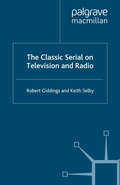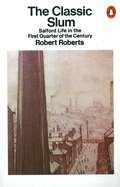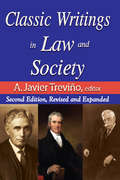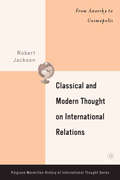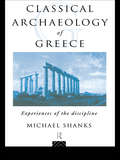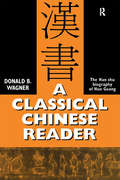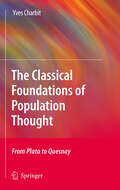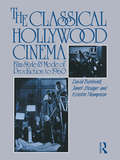- Table View
- List View
The Classic Serial on Television and Radio
by Robert Giddings Keith SelbyThe classic serial, invented by BBC Radio Drama sixty years ago, survived and adapted itself to television, the arrival of colour and the global market in what has become a flood of classics with all channels competing for ratings and overseas sales. This richly detailed book traces these developments and analyses the genre's response to social, economic, technical and cultural changes, which have re-shaped it into the form we recognise today. The book contains considerable interview material with performers and media professionals.
The Classic Slum: Salford Life in the First Quarter of the Century (Pelican Ser.)
by Robert RobertsA study which combines personal reminiscences with careful historical research, the myth of the 'good old days' is summarily dispensed with; Robert Roberts describes the period of his childhood, when the main affect of poverty in Edwardian Salford was degredation, and, despite great resources of human courage, few could escape such a prison.
Classic Writings for a Phenomenology of Practice (Phenomenology of Practice)
by Michael Van Manen Max Van ManenClassic Writings for a Phenomenology of Practice features examples of newly translated classic phenomenological texts that have been largely forgotten or misunderstood. The writings are unique in that they speak to the practice of doing phenomenological research for the purpose of gaining insights and better understandings regarding aspects of professional practice and ordinary life phenomena and events. Phenomenology does not have to be impenetrable philosophy, dealing with tedious technical issues. Instead, phenomenology may offer relevance, value, and enduring allure to readers and researchers who are engaged with the quotidian life experiences and events of students, patients, clients, friends, and other individuals. This phenomenological approach aims to stay as close as possible to the ordinary events of everyday life: seeing the first smile of a child, feeling compulsive, being humorous, having a conversation, experiencing childhood secrecy, encountering new things—topics that span a manifold of life experiences. In this collection of classic phenomenological writings, each author is thoughtfully introduced, and each text is followed by a conversational descant: a reflection on the phenomenological reflection. The presentation of these classic writings and their reflections aims to show us what it means to do phenomenology directly on the phenomena that we live—thus asking us to be attentive to the fascinating varieties and subtleties of primal lived experiences and consciousness in all its remarkable complexities. This book is relevant for scholars and students who are interested in human science research and the origins and practices of the phenomenological method.
Classic Writings for a Phenomenology of Practice (Phenomenology of Practice)
by Michael van Manen; Max van ManenClassic Writings for a Phenomenology of Practice features examples of newly translated classic phenomenological texts that have been largely forgotten or misunderstood. The writings are unique in that they speak to the practice of doing phenomenological research for the purpose of gaining insights and better understandings regarding aspects of professional practice and ordinary life phenomena and events. Phenomenology does not have to be impenetrable philosophy, dealing with tedious technical issues. Instead, phenomenology may offer relevance, value, and enduring allure to readers and researchers who are engaged with the quotidian life experiences and events of students, patients, clients, friends, and other individuals. This phenomenological approach aims to stay as close as possible to the ordinary events of everyday life: seeing the first smile of a child, feeling compulsive, being humorous, having a conversation, experiencing childhood secrecy, encountering new things—topics that span a manifold of life experiences. In this collection of classic phenomenological writings, each author is thoughtfully introduced, and each text is followed by a conversational descant: a reflection on the phenomenological reflection. The presentation of these classic writings and their reflections aims to show us what it means to do phenomenology directly on the phenomena that we live—thus asking us to be attentive to the fascinating varieties and subtleties of primal lived experiences and consciousness in all its remarkable complexities. This book is relevant for scholars and students who are interested in human science research and the origins and practices of the phenomenological method.
Classic Writings in Law and Society: Contemporary Comments and Criticisms
by A. Javier TrevinoThis volume consists of outstanding essays by contemporary scholars and specialists on classic writings in law and society. This second edition expands the previous volume by adding additional statements. Included are commentaries on Edward A. Ross's Social Control: A Survey of the Foundations of Order, Karl N. Llewellyn's Jurisprudence: Realism in Theory and Practice, Jerome Frank's Law and the Modern Mind, Leon Petrazycki's Law and Morality, and Karl Renner's The Institutions of Private Law and their Social Functions.The goal of Classic Writings in Law and Society is to acquaint a new generation of students with classic writings by diverse social and legal scholars ranging from Henry Sumner Maine, Oliver Wendell Holmes, Jr., and Hans Kelsen to Eugen Ehrlich, Nicholas S. Timasheff, and Richard Quinney. This work continues to demonstrate their contemporary theoretical relevance. Accordingly, each chapter speaks of the scholars' work in general, how the particular book under consideration fits into that corpus, and how the book is assessed in a present day context. These essays have a clear relation to the "classic" tradition in sociolegal thought.Reading the classics is useful in gaining a better understanding and appreciation of the essential foundation for a post-classic approach in law and social inquiry an approach that can be found in such orientations as critical legal studies, chaos theory in law, and legal semiotics. Classic Writings in Law and Society includes commentaries that consider early writings that set the standard for the social scientific approach in examining issues of law and punishment, social control, joint stock companies, business firms and nation-states in the study of law and society.
Classic Writings in Law and Society: Contemporary Comments and Criticisms
by A. Javier TreviñoThis volume consists of outstanding essays by contemporary scholars and specialists on classic writings in law and society. This second edition expands the previous volume by adding additional statements. Included are commentaries on Edward A. Ross's Social Control: A Survey of the Foundations of Order, Karl N. Llewellyn's Jurisprudence: Realism in Theory and Practice, Jerome Frank's Law and the Modern Mind, Leon Petrazycki's Law and Morality, and Karl Renner's The Institutions of Private Law and their Social Functions.The goal of Classic Writings in Law and Society is to acquaint a new generation of students with classic writings by diverse social and legal scholars ranging from Henry Sumner Maine, Oliver Wendell Holmes, Jr., and Hans Kelsen to Eugen Ehrlich, Nicholas S. Timasheff, and Richard Quinney. This work continues to demonstrate their contemporary theoretical relevance. Accordingly, each chapter speaks of the scholars' work in general, how the particular book under consideration fits into that corpus, and how the book is assessed in a present day context. These essays have a clear relation to the "classic" tradition in sociolegal thought.Reading the classics is useful in gaining a better understanding and appreciation of the essential foundation for a post-classic approach in law and social inquiry an approach that can be found in such orientations as critical legal studies, chaos theory in law, and legal semiotics. Classic Writings in Law and Society includes commentaries that consider early writings that set the standard for the social scientific approach in examining issues of law and punishment, social control, joint stock companies, business firms and nation-states in the study of law and society.
Classical and Modern Thought on International Relations: From Anarchy to Cosmopolis (The Palgrave Macmillan History of International Thought)
by R. JacksonIn the tradition of the English School of International Relations theory, this project from Robert Jackson seeks to show how continuities in international politics outweigh the changes. The author demonstrates how the world is neither one of anarchy, as put forward by realists, nor is it a fully cosmopolitan order, as argued by those on the other side of the theoretical spectrum. Instead, it is a world of states who acknowledge a set of moral constraints that exists between them.
Classical Archaeology (Wiley Blackwell Studies in Global Archaeology #18)
by Susan E. Alcock Robin OsborneThe fully revised second edition of this successful volume includes updates on the latest archaeological research in all chapters, and two new essays on Greek and Roman art. It retains its unique, paired essay format, as well as key contributions from leading archaeologists and historians of the classical world. Second edition is updated and revised throughout, showcasing the latest research and fresh theoretical approaches in classical archaeology Includes brand new essays on ancient Greek and Roman art in a modern context Designed to encourage critical thinking about the interpretation of ancient material culture and the role of modern perceptions in shaping the study of art and archaeology Features paired essays – one covering the Greek world, the other, the Roman – to stimulate a dialogue not only between the two ancient cultures, but between scholars from different historiographic and methodological traditions Includes maps, chronologies, diagrams, photographs, and short editorial introductions to each chapter
Classical Archaeology (Wiley Blackwell Studies in Global Archaeology #17)
by Susan E. Alcock Robin OsborneThe fully revised second edition of this successful volume includes updates on the latest archaeological research in all chapters, and two new essays on Greek and Roman art. It retains its unique, paired essay format, as well as key contributions from leading archaeologists and historians of the classical world. Second edition is updated and revised throughout, showcasing the latest research and fresh theoretical approaches in classical archaeology Includes brand new essays on ancient Greek and Roman art in a modern context Designed to encourage critical thinking about the interpretation of ancient material culture and the role of modern perceptions in shaping the study of art and archaeology Features paired essays – one covering the Greek world, the other, the Roman – to stimulate a dialogue not only between the two ancient cultures, but between scholars from different historiographic and methodological traditions Includes maps, chronologies, diagrams, photographs, and short editorial introductions to each chapter
The Classical Archaeology of Greece: Experiences of the Discipline (The\experience Of Archaeology Ser.)
by Michael ShanksArchaeologists do not discover the past but take the fragmentary remains which they recover and make something of them. Archaeology is a process of detection and supposition; this is what makes it so fascinating. However, the interpretations of archaeologists differ and change over time. They depend upon the amount of evidence available, the ideas and preconceptions of the archaeologist and their interests and aims.Michael Shanks's enlivening work is a guide to the discipline of classical archaeology and its objects. It assesses archaeology as a means of reconstructing ancient Greek society using the latest approaches of social archaeology. In addition, The Classical Archaeology of Greece outlines the history of the discipline and discusses why Classical Greece continues to fascinate us and why it has had such an impact on European civilization and identity.
The Classical Archaeology of Greece: Experiences of the Discipline
by Michael ShanksArchaeologists do not discover the past but take the fragmentary remains which they recover and make something of them. Archaeology is a process of detection and supposition; this is what makes it so fascinating. However, the interpretations of archaeologists differ and change over time. They depend upon the amount of evidence available, the ideas and preconceptions of the archaeologist and their interests and aims.Michael Shanks's enlivening work is a guide to the discipline of classical archaeology and its objects. It assesses archaeology as a means of reconstructing ancient Greek society using the latest approaches of social archaeology. In addition, The Classical Archaeology of Greece outlines the history of the discipline and discusses why Classical Greece continues to fascinate us and why it has had such an impact on European civilization and identity.
A Classical Chinese Reader: The Han Shu biography of Huo Guang
by Donald B. WagnerDesigned as an advanced/intermediate level textbook for students, this book will meet the needs of those making the transition between 'textbook texts' to 'real texts'. Dr Wagner's many years' experience of teaching classical Chinese are brought to bear on one of the most difficult aspects of learning the language - making the progression from introductory textbooks on classical Chinese, which do not present serious philological problems, to real historical texts, in which such problems abound. The text used is the biography of Huo Guang in the Han Shu together with the commentaries compiled by Yan Shigu.
A Classical Chinese Reader: The Han Shu biography of Huo Guang
by Donald B. WagnerDesigned as an advanced/intermediate level textbook for students, this book will meet the needs of those making the transition between 'textbook texts' to 'real texts'. Dr Wagner's many years' experience of teaching classical Chinese are brought to bear on one of the most difficult aspects of learning the language - making the progression from introductory textbooks on classical Chinese, which do not present serious philological problems, to real historical texts, in which such problems abound. The text used is the biography of Huo Guang in the Han Shu together with the commentaries compiled by Yan Shigu.
Classical Culture and Witchcraft in Medieval and Renaissance Italy (Palgrave Historical Studies in Witchcraft and Magic)
by Marina MontesanoThis book explores the relationships between ancient witchcraft and its modern incarnation, and by doing so fills an important gap in the historiography. It is often noted that stories of witchcraft circulated in Greek and Latin classical texts, and that treatises dealing with witch-beliefs referenced them. Still, the role of humanistic culture and classical revival in the developing of the witch-hunts has not yet been fully researched. Marina Montesano examines Greek and Latin literature, revealing how particular features of ancient striges were carried into the Late Middle Ages, through the Renaissance and into the fifteenth century, when early Italian trials recall the myth of the strix common in ancient Latin sources and in popular memory. The final chapter also serves as a conclusion, to show how in Renaissance Italy and beyond, classical accounts of witchcraft ceased to be just stories, as they had formerly been, and were instead used to attest to the reality of witches’ powers.
Classical Culture and Witchcraft in Medieval and Renaissance Italy (Palgrave Historical Studies in Witchcraft and Magic)
by Marina MontesanoThis book explores the relationships between ancient witchcraft and its modern incarnation, and by doing so fills an important gap in the historiography. It is often noted that stories of witchcraft circulated in Greek and Latin classical texts, and that treatises dealing with witch-beliefs referenced them. Still, the role of humanistic culture and classical revival in the developing of the witch-hunts has not yet been fully researched. Marina Montesano examines Greek and Latin literature, revealing how particular features of ancient striges were carried into the Late Middle Ages, through the Renaissance and into the fifteenth century, when early Italian trials recall the myth of the strix common in ancient Latin sources and in popular memory. The final chapter also serves as a conclusion, to show how in Renaissance Italy and beyond, classical accounts of witchcraft ceased to be just stories, as they had formerly been, and were instead used to attest to the reality of witches’ powers.
The Classical Foundations of Population Thought: From Plato to Quesnay
by Yves CharbitWhereas the history of demography as a social science has been amply explored, that of the construction of the concept of population has been neglected. Specialists systematically ignore a noteworthy paradox: strictly speaking, the great intellectual figures of the past dealt with in this book have not produced demographic theories or doctrines as such, but they have certainly given some thought to population at both levels. First, the central epistemological and methodological orientation of the book is presented. Ideas on population, far from being part of the harmonious advancement of knowledge are the product of their context, that is evidently demographic, but also economic, political and above all intellectual. Then the ideas on population of Plato, Bodin, the French mercantilists, Quesnay and the physiocrats are examined under this light. The last chapter addresses the implicit philosophical, economic and political issues of population thought.
Classical Heritage and European Identities: The Imagined Geographies of Danish Classicism (Critical Heritages of Europe)
by Lærke Maria Andersen Funder Troels Myrup Kristensen Vinnie NørskovClassical Heritage and European Identities examines how the heritages of classical antiquity have been used to construct European identities, and especially the concept of citizenship, in Denmark from the eighteenth century to the present day. It implements a critical historiographical perspective in line with recent work on the "reception" of classical antiquity that has stressed the dialectic relationship between past, present and future. Arguing that the continuous employment and appropriation of lassical heritages in the Danish context constitutes an interesting case of an imagined geography that is simultaneously based on both national and European identities, the book shows how Denmark’s imagined geography is naturalized through very distinctive uses of classical heritages within the educational and heritage sectors. Chapter 1 of this book is freely available as a downloadable Open Access PDF under a Creative Commons Attribution-Non Commercial-No Derivatives 3.0 license. https://s3-us-west-2.amazonaws.com/tandfbis/rt-files/docs/Open+Access+Chapters/9781138317505_oachapter1.pdf
Classical Heritage and European Identities: The Imagined Geographies of Danish Classicism (Critical Heritages of Europe)
by Lærke Maria Andersen Funder Troels Myrup Kristensen Vinnie NørskovClassical Heritage and European Identities examines how the heritages of classical antiquity have been used to construct European identities, and especially the concept of citizenship, in Denmark from the eighteenth century to the present day. It implements a critical historiographical perspective in line with recent work on the "reception" of classical antiquity that has stressed the dialectic relationship between past, present and future. Arguing that the continuous employment and appropriation of lassical heritages in the Danish context constitutes an interesting case of an imagined geography that is simultaneously based on both national and European identities, the book shows how Denmark’s imagined geography is naturalized through very distinctive uses of classical heritages within the educational and heritage sectors. Chapter 1 of this book is freely available as a downloadable Open Access PDF under a Creative Commons Attribution-Non Commercial-No Derivatives 3.0 license. https://s3-us-west-2.amazonaws.com/tandfbis/rt-files/docs/Open+Access+Chapters/9781138317505_oachapter1.pdf
The Classical Hollywood Cinema: Film Style and Mode of Production to 1960
by David Bordwell Janet Staiger Kristin Thompson'A dense, challenging and important book.' Philip French Observer 'At the very least, this blockbuster is probably the best single volume history of Hollywood we're likely to get for a very long time.' Paul Kerr City Limits 'Persuasively argued, the book is also packed with facts, figures and photographs.' Nigel Andrews Financial Times Acclaimed for their breakthrough approach, Bordwell, Staiger and Thompson analyze the basic conditions of American film-making as a historical institution and consider to what extent Hollywood film production constitutes a systematic enterprise, in both its style and its business operations. Despite differences of director, genre or studio, most Hollywood films operate within a set of shared assumptions about how a film should look and sound. Such assumptions are neither natural nor inevitable; but because classical-style films have been the type most widely seen, they have come to be accepted as the 'norm' of film-making and viewing. The authors show how these classical conventions were formulated and standardized, and how they responded to the arrival of sound, colour, widescreen ratios and stereophonic sound. They argue that each new technological development has served a function within an existing narrational system. The authors also examine how the Hollywood cinema standardized the film-making process itself. They describe how, over the course of its history, Hollywood developed distinct modes of production in a constant search for maximum efficiency, predictability and novelty. Set apart by its combination of theoretical analysis and empirical evidence, this book is the standard work on the classical Hollywood cinema style of film-making from the silent era to the 1960s. Now available in paperback, it is a 'must' for film students, lecturers and all those seriously interested in the development of the film industry.
The Classical Hollywood Cinema: Film Style and Mode of Production to 1960
by David Bordwell Janet Staiger Kristin Thompson'A dense, challenging and important book.' Philip French Observer 'At the very least, this blockbuster is probably the best single volume history of Hollywood we're likely to get for a very long time.' Paul Kerr City Limits 'Persuasively argued, the book is also packed with facts, figures and photographs.' Nigel Andrews Financial Times Acclaimed for their breakthrough approach, Bordwell, Staiger and Thompson analyze the basic conditions of American film-making as a historical institution and consider to what extent Hollywood film production constitutes a systematic enterprise, in both its style and its business operations. Despite differences of director, genre or studio, most Hollywood films operate within a set of shared assumptions about how a film should look and sound. Such assumptions are neither natural nor inevitable; but because classical-style films have been the type most widely seen, they have come to be accepted as the 'norm' of film-making and viewing. The authors show how these classical conventions were formulated and standardized, and how they responded to the arrival of sound, colour, widescreen ratios and stereophonic sound. They argue that each new technological development has served a function within an existing narrational system. The authors also examine how the Hollywood cinema standardized the film-making process itself. They describe how, over the course of its history, Hollywood developed distinct modes of production in a constant search for maximum efficiency, predictability and novelty. Set apart by its combination of theoretical analysis and empirical evidence, this book is the standard work on the classical Hollywood cinema style of film-making from the silent era to the 1960s. Now available in paperback, it is a 'must' for film students, lecturers and all those seriously interested in the development of the film industry.
Classical Hollywood Comedy (AFI Film Readers)
by Kristine Brunovska Karnick Henry JenkinsApplies the recent `return to history' in film studies to the genre of classical Hollywood comedy as well as broadening the definition of those works considered central in this field.
Classical Hollywood Comedy (AFI Film Readers)
by Kristine Brunovska Karnick Henry JenkinsApplies the recent `return to history' in film studies to the genre of classical Hollywood comedy as well as broadening the definition of those works considered central in this field.
Classical Hollywood Film Cycles (Routledge Advances in Film Studies)
by Zoe WallinThis book explores the ways in which Hollywood film cycles from the 1930s to the 1960s were shaped by their surrounding industrial contexts and market environments, to build an inclusive conception of the form, operation, and function of film cycles. By foregrounding patterns of distribution, spaces of exhibition, and modes of consumption as key components of the form and mechanics of cycles, this book develops a methodology for defining cycles based on an analysis of the industry and trade discourse. Applying her unique framework to six case studies of different cycles, Zoe Wallin blends a wide range of historical sources to analyze the many cultural, social, political, aesthetic, and industrial contexts relevant to these films. This book makes an important contribution to the literature in the area of film historiography, and will be of interest to any scholars of film studies, history and media studies.
Classical Hollywood Film Cycles (Routledge Advances in Film Studies)
by Zoe WallinThis book explores the ways in which Hollywood film cycles from the 1930s to the 1960s were shaped by their surrounding industrial contexts and market environments, to build an inclusive conception of the form, operation, and function of film cycles. By foregrounding patterns of distribution, spaces of exhibition, and modes of consumption as key components of the form and mechanics of cycles, this book develops a methodology for defining cycles based on an analysis of the industry and trade discourse. Applying her unique framework to six case studies of different cycles, Zoe Wallin blends a wide range of historical sources to analyze the many cultural, social, political, aesthetic, and industrial contexts relevant to these films. This book makes an important contribution to the literature in the area of film historiography, and will be of interest to any scholars of film studies, history and media studies.
The Classical Hollywood Reader
by Steve NealeThe Classical Hollywood Reader brings together essential readings to provide a history of Hollywood from the 1910s to the mid 1960s. Following on from a Prologue that discusses the aesthetic characteristics of Classical Hollywood films, Part 1 covers the period between the 1910s and the mid-to-late 1920s. It deals with the advent of feature-length films in the US and the growing national and international dominance of the companies responsible for their production, distribution and exhibition. In doing so, it also deals with film making practices, aspects of style, the changing roles played by women in an increasingly business-oriented environment, and the different audiences in the US for which Hollywood sought to cater. Part 2 covers the period between the coming of sound in the mid 1920s and the beginnings of the demise of the `studio system` in late 1940s. In doing so it deals with the impact of sound on films and film production in the US and Europe, the subsequent impact of the Depression and World War II on the industry and its audiences, the growth of unions, and the roles played by production managers and film stars at the height of the studio era. Part 3 deals with aspects of style, censorship, technology, and film production. It includes articles on the Production Code, music and sound, cinematography, and the often neglected topic of animation. Part 4 covers the period between 1946 and 1966. It deals with the demise of the studio system and the advent of independent production. In an era of demographic and social change, it looks at the growth of drive-in theatres, the impact of television, the advent of new technologies, the increasing importance of international markets, the Hollywood blacklist, the rise in art house imports and in overseas production, and the eventual demise of the Production Code. Designed especially for courses on Hollywood Cinema, the Reader includes a number of newly researched and written chapters and a series of introductions to each of its parts. It concludes with an epilogue, a list of resources for further research, and an extensive bibliography.
